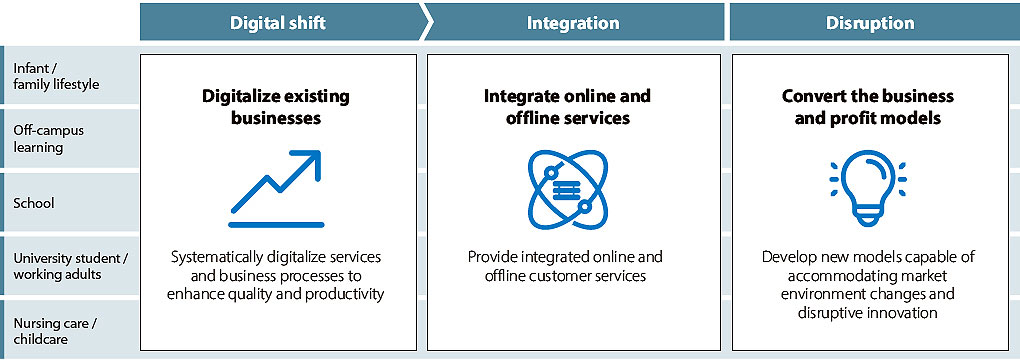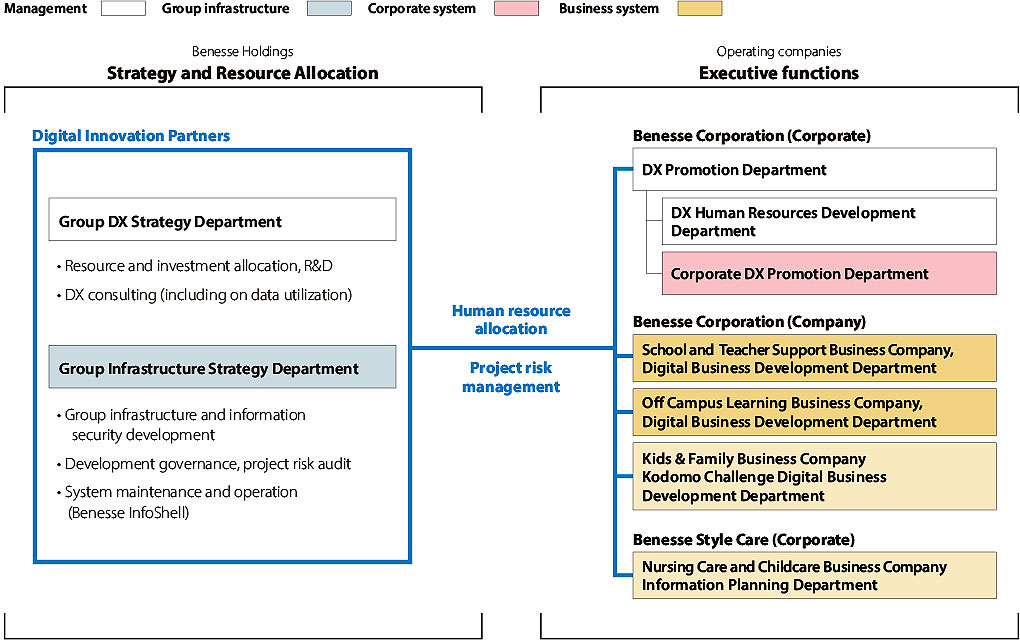Message from the CDO
Enhancing the Group’s digital technology capabilities
to continue offering products and services
meeting customer needs
Hidetomo HashimotoExecutive Officer, Chief Digital Officer, Managing Director of Group DX Strategy



- Group-wide DX on the Group level and for the individual business units
- New Group-level unit for planning and promoting DX strategies
- A corporate group always providing the best products and services for its customers
- Specific measures 1 | DX promotion according to the business phase of digitalization
- Specific measures 2 | Improving the organization’s overall DX capabilities
Group-wide DX on the Group level and for the individual business units
The Benesse Group’s diverse businesses each have their own unique customer base, business model, and competitive environment. Each business therefore must undertake its own form of DX with a detailed strategy matched to its unique characteristics and current level of digitalization. At the same time, certain aspects must be approached on the Group level, such as the personnel training and system infrastructure construction needed for DX.
With this in mind, we are following two main tracks to advance our DX: introducing DX tailored to each business’ phase of digitalization and improving the organization’s overall DX capabilities. Each business’ level of digitalization will be categorized into one of three phases of digital shift, integration, or disruption, and the application of the digital technologies to each product and service will be based on the business’ market and competitive environments. Improving the Group’s overall DX capabilities will entail addressing the various issues across the Group to enable us to harness the digital technology for sustaining growth, including training DX human resources, strengthening our partnerships with specialists inside and outside the Group, and preparing the organizational structure and system infrastructure for digital operations.
DX strategies tailored to business characteristics

New Group-level unit for planning and promoting DX strategies
The Digital Innovation Partners (DIP) unit was created in April 2021 to direct the steady advancement of the Group’s DX. Combining the Digital Department, IT Department, Human Resources Development Department, and a Consulting Department for DX promotion led by the Chief Digital Officer (CDO), the DIP is directing all aspects of the DX strategies for all departments and Group companies from preparing strategies to allocating resources and investments and implementing specific DX measures.
The Benesse Group is accelerating its DX strategy by implementing specific priority measures, led by the DIP, on the Group level and for each of the individual business units.
DX promotion scheme

A corporate group always providing the best products and services for its customers
The ultimate goal of our DX strategy is to “continue being a company that always provides the best products and services.” The Group’s products and services are highly regarded in the market, but the advances in digital technology are creating a steady stream of new services and market disruptors. These conditions mean that there is no guarantee that our methods and services will necessarily continue to be the best in the market.
We want to use DX to enhance our ability to quickly respond the moment that a customer thinks of a new type of service that would meet their need. Digitalization is a means to achieving that, but it cannot be achieved by digitalization alone. The goal we need to shoot for is to use our customer base and the knowledge and know-how in the nursing care and education fields that we have created in our past businesses and combine them with new technologies, functions, and business models to continue providing the best value on the market.
Specific measures 1DX promotion according to the business phase of digitalization
Dispatching in-house consultants to accelerate the digital shift at each site
We are advancing the DX for each business with initiatives geared to three phases of digitalization.
All businesses are digitalizing non-digital services and business processes in stages to bring about a digital shift that will stabilize quality and improve productivity. For businesses in fields where digitalizing products and services face special challenges, DIP is dispatching highly skilled DX human resources to help them make a successful shift.
The three main areas in which DIP is providing support are data utilization, digital marketing, and operating efficiency improvement. Employees who are deeply familiar with the specific issues of each business site are acting as consultants to support digitalization at the business divisions. The ultimate objective of the consultation is to help each business site gain the organizational capability to diagnose its specific needs so they can proceed with their digital shift independently. Each business division’s results will also be shared with other divisions to boost the overall effectiveness of our organizational abilities.
Digital shift project

Building foundations for data utilization in each business
Once businesses and services bring about the digital shift, they will then begin focusing on making effective use of the digitalized data. We are therefore also working to build the foundations that will enable the business divisions to make effective use of the data.
We will explore how the data can be used to grow the business and then experiment to see what works. When results with potential are found, IT infrastructure will be created to collect and analyze data, human resources will be trained to analyze the data, and support will be provided to create and standardize the analysis environment and processes so that the business divisions become fully capable of utilizing the data and operating the business on their own.
On watch for disruption using industry landscape maps
The Group’s wide range of businesses in various fields presents a high risk of exposure to digital disruption. We are therefore constantly on “disruption watch” by objectively assessing the changes in the competitive environment and our Company’s strengths.
We use desk research to identify new service trends in the industry and with venture firms around the world, and create industry landscape maps for each business area and category. Business managers and on-site digital managers use the maps to monitor for signs of change in the landscape, such as what kind of players are increasing in which categories and where capital is being directed. When a potential disruptor arises, we will consider building a relationship, such to co-create, collaborate, and cooperate in a business. We are also exploring markets and service fields where we can move in as a disruptor.
Specific measures 2Improving the organization’s overall DX capabilities
Systematic personnel allocation and development using visualization of digital skills
DX human resources will be developed using a system of six types of work content and three skill levels for each type of work. Individual skill levels will be assessed, including evaluations using external assessment standards, and the related data will be input to a management system. We systematically assign, train, and hire DX human resources based on an accurate identification of how many personnel with what specialty and skill level are needed in which department. If a gap is found, for example, between our current capabilities and the specialties and skill levels needed for a certain business area, we will boost our organizational capabilities by training in-house employees or hiring professionals from outside the organization. To boost individual employee skills, we are also currently developing several original training programs based on case studies in each business.
Clearly identifying the skills needed for each business site will give us greater flexibility to allocate DX human resources within the Group. The possibility to transfer across business divisions and departments is also beneficial for motivating and recruiting DX human resources. Benesse Corporation is currently using this system for its employees, and we plan to expand it to other operating companies in the future.

Redesigning system architecture as the business evolves
As our businesses have evolved, the systems that were designed and developed for specific services have become outdated legacy systems, with some systems even becoming technological liabilities. As we redesign our system architecture, we will create even stronger coordination between the System Development Department and the business divisions. Business planning and system planning will be combined together, and we will gradually redesign the system architecture as our business plans evolve. The system infrastructure will be migrated to the cloud environment, which will reduce costs while enabling us to flexibly respond to change and improve system quality.
We will also implement more sophisticated information security measures based on the zero trust model as we continue making greater use of the cloud environment, software as a service (SaaS) and application service provider (ASP), and collaboration with external partners as well as telecommuting and remote work.
Further enhancing development governance effectiveness
System development governance will also be enhanced, which will increase development quality and improve our ability to quickly provide stable services. For this purpose, we have created a specialized team to examine the system architecture suitability and identify any risks that arise with the DX. The team monitors the progress of the important development projects within the Group to identify and assist in responding to any issues or risks.
The specific experiences and the expertise the team gains during its activities will also be shared throughout the Group to train project leaders and further enhance our DX organizational capabilities.
Last updated : 2021/11/09
- TOP
- Investor Relations
- Integrated Report
- Benesse Integrated Report 2021
- Message from the CDO